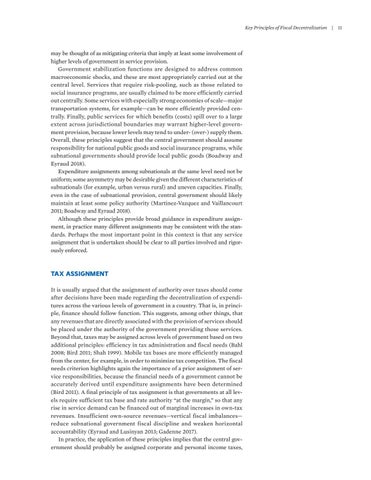Key Principles of Fiscal Decentralization | 11
may be thought of as mitigating criteria that imply at least some involvement of higher levels of government in service provision. Government stabilization functions are designed to address common macroeconomic shocks, and these are most appropriately carried out at the central level. Services that require risk-pooling, such as those related to social insurance programs, are usually claimed to be more efficiently carried out centrally. Some services with especially strong economies of scale—major transportation systems, for example—can be more efficiently provided centrally. Finally, public services for which benefits (costs) spill over to a large extent across jurisdictional boundaries may warrant higher-level government provision, because lower levels may tend to under- (over-) supply them. Overall, these principles suggest that the central government should assume responsibility for national public goods and social insurance programs, while subnational governments should provide local public goods (Boadway and Eyraud 2018). Expenditure assignments among subnationals at the same level need not be uniform; some asymmetry may be desirable given the different characteristics of subnationals (for example, urban versus rural) and uneven capacities. Finally, even in the case of subnational provision, central government should likely maintain at least some policy authority (Martinez-Vazquez and Vaillancourt 2011; Boadway and Eyraud 2018). Although these principles provide broad guidance in expenditure assignment, in practice many different assignments may be consistent with the standards. Perhaps the most important point in this context is that any service assignment that is undertaken should be clear to all parties involved and rigorously enforced.
TAX ASSIGNMENT It is usually argued that the assignment of authority over taxes should come after decisions have been made regarding the decentralization of expenditures across the various levels of government in a country. That is, in principle, finance should follow function. This suggests, among other things, that any revenues that are directly associated with the provision of services should be placed under the authority of the government providing those services. Beyond that, taxes may be assigned across levels of government based on two additional principles: efficiency in tax administration and fiscal needs (Bahl 2008; Bird 2011; Shah 1999). Mobile tax bases are more efficiently managed from the center, for example, in order to minimize tax competition. The fiscal needs criterion highlights again the importance of a prior assignment of service responsibilities, because the financial needs of a government cannot be accurately derived until expenditure assignments have been determined (Bird 2011). A final principle of tax assignment is that governments at all levels require sufficient tax base and rate authority “at the margin,” so that any rise in service demand can be financed out of marginal increases in own-tax revenues. Insufficient own-source revenues—vertical fiscal imbalances— reduce s ubnational government fiscal discipline and weaken horizontal accountability (Eyraud and Lusinyan 2013; Gadenne 2017). In practice, the application of these principles implies that the central government should probably be assigned corporate and personal income taxes,






